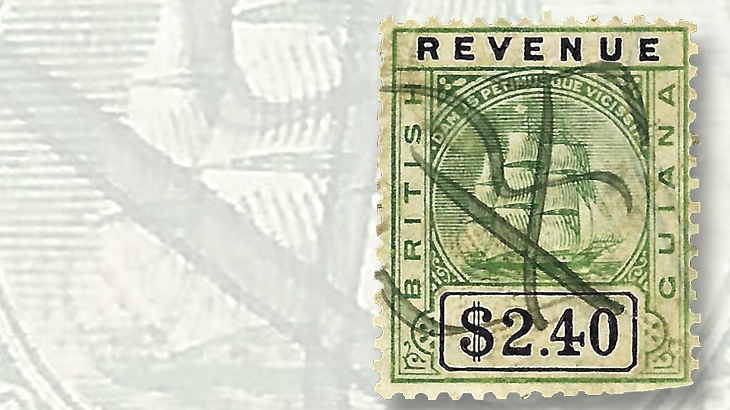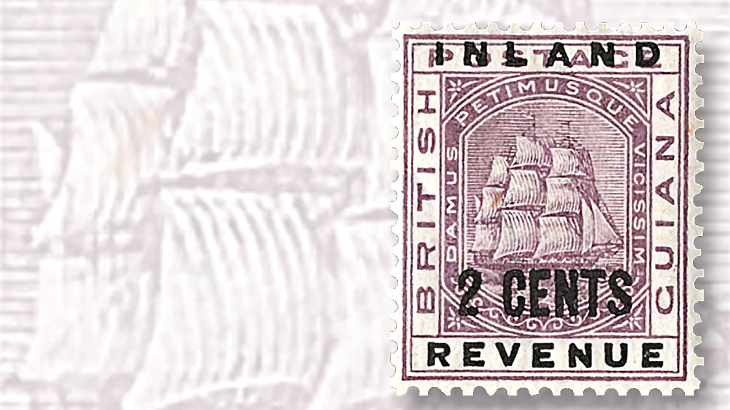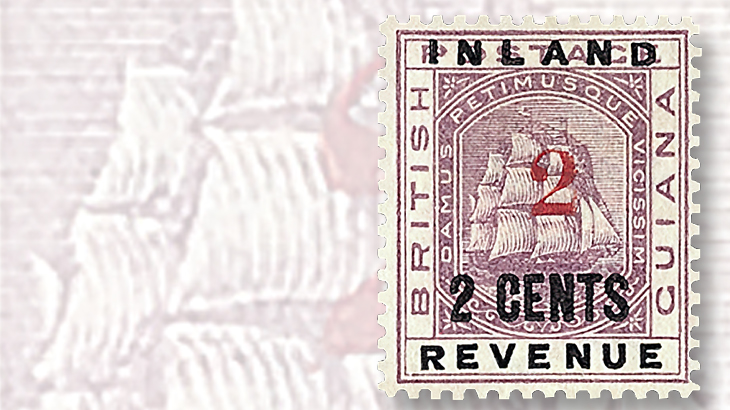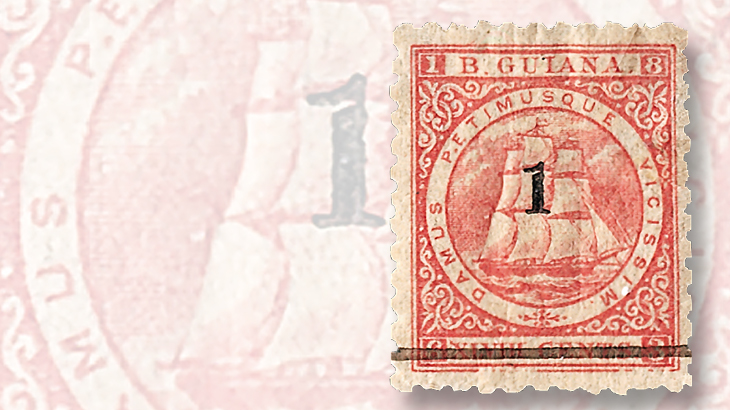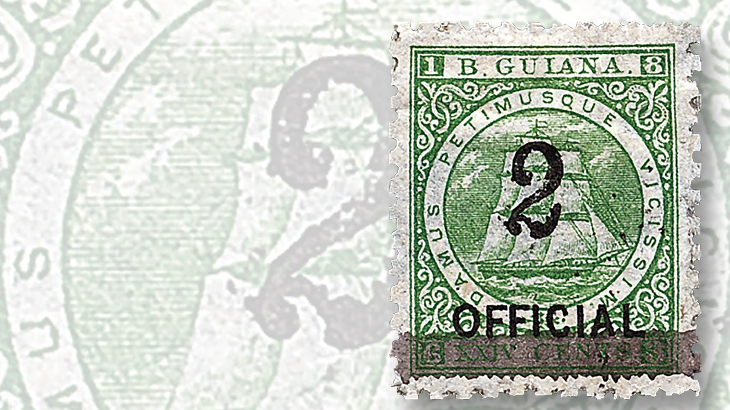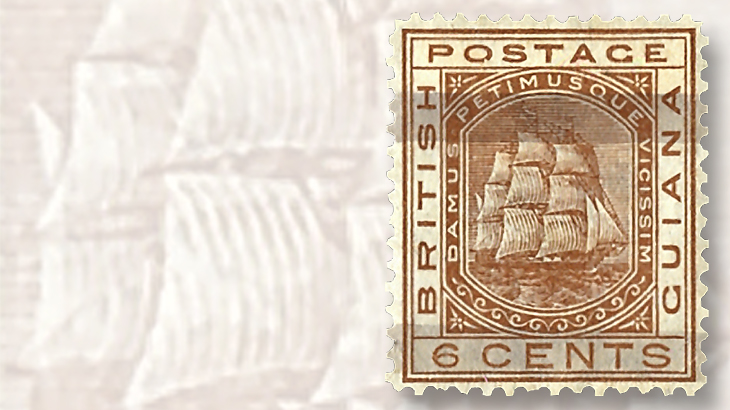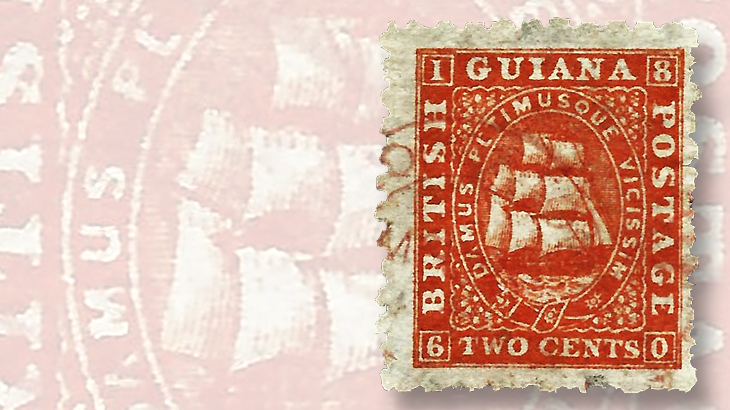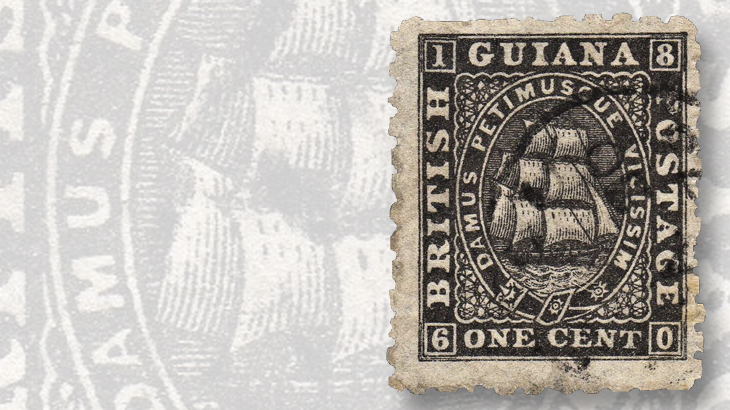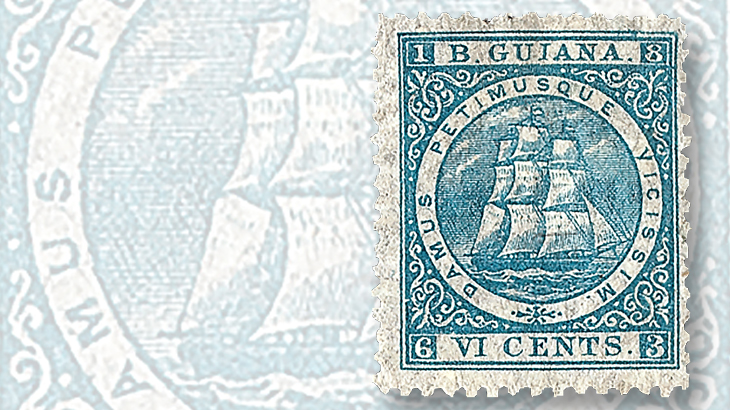World Stamps
Modest British Guiana stamps mimic designs of the pricey classics
Stamp Collecting Basics — By Janet Klug
Many collectors back away from collecting stamps from countries that have super-expensive stamps. This is a shame, because in addition to the often-unattainable stamps, there usually are other more affordable stamps within the country that are fascinating, beautiful, and full of history.
In the case of British Guiana, only one person can own Scott 13, the unique 1856 1¢ Magenta stamp that sold for $9.48 million in 2014.
However, that issue and other very rare British Guiana stamps shouldn’t stop anyone from collecting the other wonderful stamps of that British colony.
Connect with Linn’s Stamp News:
Sign up for our newsletter
Like us on Facebook
Follow us on Twitter
A little larger than the state of Kansas (and larger still than the entire country of England), British Guiana was on the northern coast of South America.
The earliest issues of British Guiana depict a masted sailing ship with the colony’s motto around it: the Latin words, “Damus Petimusque Vicissim” (“We give and we ask in return”).
Beginning with issues of 1866, British Guiana stamps begin to fit into the more affordable range, yet they have designs similar to the earlier expensive issues.
For example, a beautiful 1¢ black stamp showing the colony’s seal was issued in 1866 (Scott 50). The center of the seal pictures a sailing ship known as a Blackwall frigate, a type of three-masted, full-rigged ship so named because of its origin at Blackwall shipyard in London, on the Thames River.
A 2¢ stamp (Scott 51) was issued in 1866 showing a Blackwall frigate in orange.
There are many more Seal of the Colony stamps with the ship, printed on thin or thick paper with various perforations and watermarks.
The more you delve into British Guiana stamps and the variations of this Ship-type design, the more likely it is that you will find interesting varieties, surcharges, and overprints. It can become addictive.
Some of the Seal of the Colony (Ship) stamps use Roman numerals for the denomination; for example, “VI CENTS” on the 6¢ stamp of 1863 (Scott 64).
In 1878, by official decrees, some of the Seal of the Colony stamps were overprinted, with examples shown in the Scott Standard Postage Stamp Catalogue and the Scott Classic Specialized Catalogue of Stamps and Covers 1840-1940 under the heading, “Stamps Surcharged by Brush-like Pen Lines.” They are interesting stamps but not particularly beautiful.
There are four different brush-like surcharge types (a through d) illustrated in the Scott catalog, in various combinations of horizontal lines, sometimes with a vertical line as well. The horizontal lines crossed out the old denomination or the word “OFFICIAL,” or both the denomination and “OFFICIAL.”
The catalog values for these surcharged issues range from $45 to $550, with the rarest one (Scott 85a, Type b) at a stunning $50,000 — so yes, they might stretch your budget more than a bit.
Is it worth it? That is up to you.
In 1881, Seal of the Colony stamps, including some unissued Official (government use) stamps with the design, were surcharged with a 1¢ or 2¢ overprint (Scott 92-95). These are small stamps with small surcharges and, in some instances, big catalog values for unused as well as used stamps.
The Seal of the Colony designs were modeled to perform a lot of different jobs. Some were overprinted with the words “INLAND REVENUE” and surcharged in 1889. There are denominations that go from 1¢ to $5 (Scott 112-128), with catalog values rising as the denominations go higher. The lower denominations are quite wallet-friendly.
Some of the Inland Revenue overprinted and surcharged stamps were surcharged a second time, in 1889, resulting in the 2¢-on-2¢ denomination on Scott 129.
Further in 1889, some issues showing the seal of the colony were redesigned, with the box at the top of the stamps that reads “POSTAGE” becoming “POSTAGE & REVENUE” (Scott 130-147).
Soon after, in 1890, high-denomination $1, $2, $3, and $4 Seal of the Colony postage issues were overprinted “INLAND REVENUE” and surcharged with a “ONE CENT” denomination (Scott 148-151B).
The two denomination changes and double lines running through the original denomination make these stamps pretty interesting.
Sometime during 1905-10, an earlier Seal of the Colony stamp was overprinted “POSTAGE AND REVENUE” and a box added at the foot of the stamp with the denomination $2.40 (Scott 171).
A similar stamp overprinted “REVENUE” and given the denomination of $2.40, as a revenue stamp, is not listed in the Scott Standard catalog.
Stamps overprinted “OFFICIAL” in red or black round out the Seal of the Colony ship-type stamps, as well as the British Guiana listings in the Scott Standard catalog.
Scott O2, the 2¢ orange stamp and the first-listed black “OFFICIAL” overprint, issued in 1875, is modestly valued in used condition. Treat yourself to this one.
The British Guiana listings in the Scott Standard catalog end in 1966, when the colony became the independent state of Guyana on May 26 of that year.
The moral of this story is that you can skip past the most expensive of the British Guiana stamps and still achieve collecting satisfaction through stamps using the attractive Blackwall frigate designs based on the seal of the colony.
These are classic British Guiana stamps of the 19th and early 20th century.
And, having fallen in love with the colony’s issues, you can go on from there and introduce yourself to Guyana. This enables you to move your collection through the attractive pictorial stamps of the King George V period, go forward with King George VI and then proceed with Queen Elizabeth II. The stamps are readily available and most of them are easy on the budget.
Want to know more about British Guiana/Guyana stamps? Join the Guyana Philatelic Society, Box 3127, Vista, CA 92085; or visit the society’s website. Membership is free.
MORE RELATED ARTICLES
Headlines
-
US Stamps
Oct 7, 2024, 3 PMMcMurtrie dismissed as APS education director following Sept. 21 arrest
-
US Stamps
Oct 7, 2024, 12 PMVasiliauskas named president of Mystic Stamp Co.
-
US Stamps
Oct 6, 2024, 5 PMApgar souvenir card available
-
US Stamps
Oct 6, 2024, 4 PMFirst Continental Congress and U.N. stamps receive Scott catalog numbers

